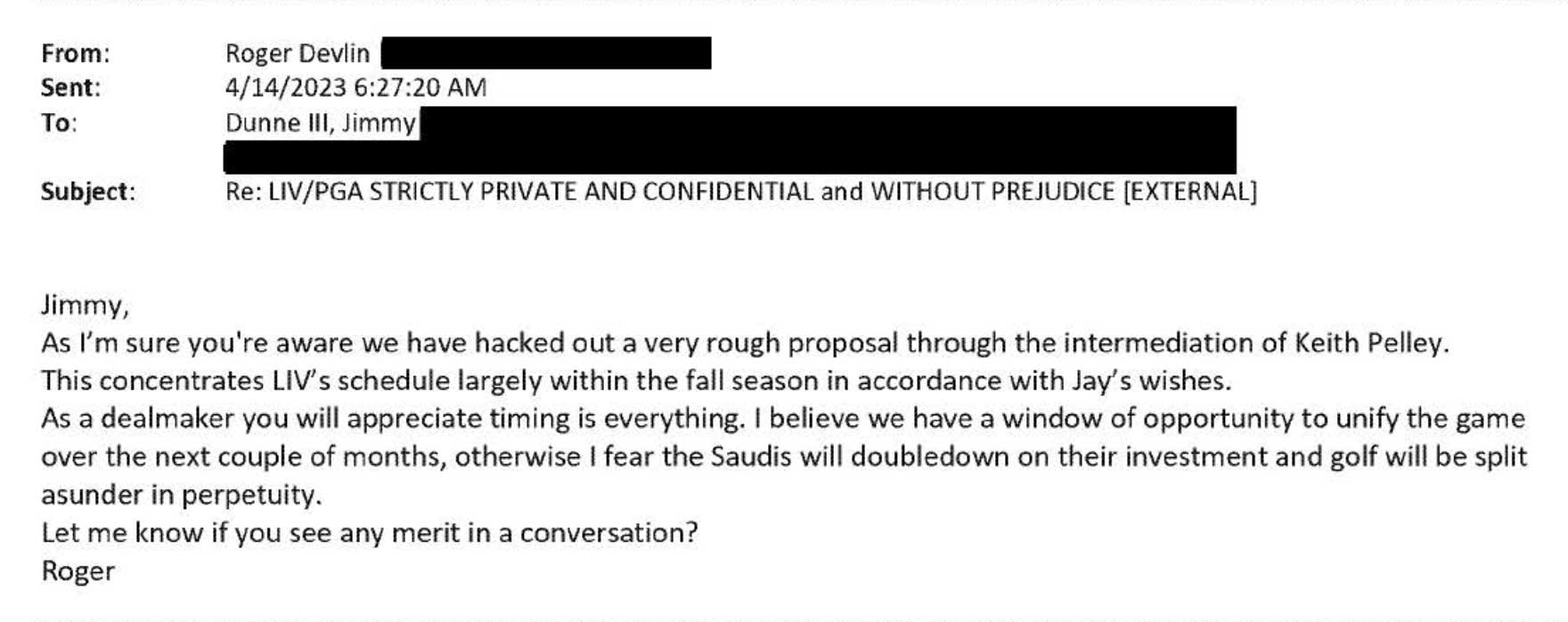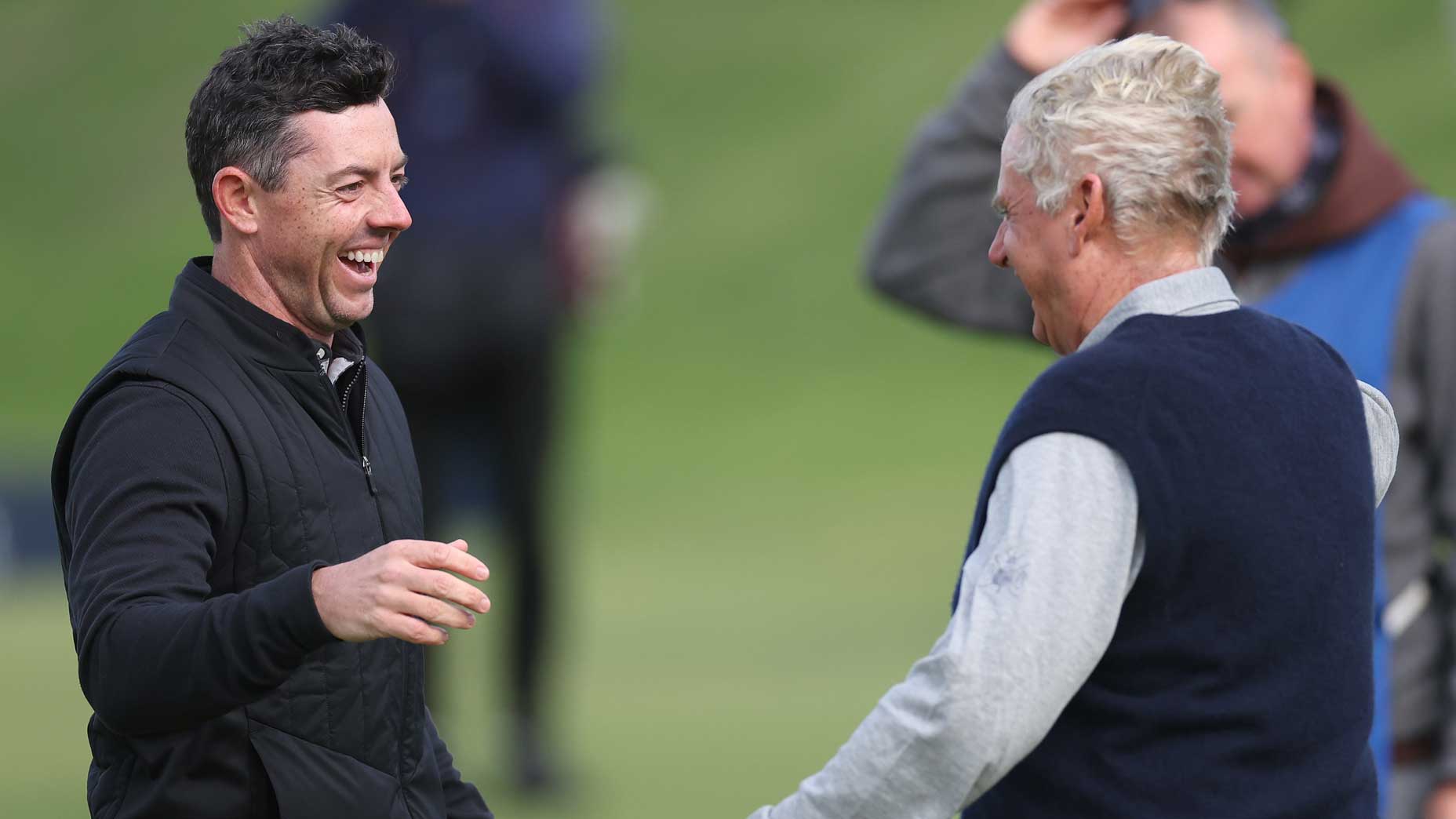New PGA Tour-PIF court docs detail origins of shocking deal

On Wednesday, June 7, the day after everything changed, Rory McIlroy stepped to the microphone.
The dust hadn’t yet begun to settle after a shocking announcement the day before: an agreement had been reached between the PGA Tour and the Saudi Public Investment Fund, the backers of LIV, golf’s controversial disruptor. At the RBC Canadian Open, every Tour pro was blindsided — McIlroy included. He’d found out about the deal just hours before the rest of the world, he said. And while he could see why it’d been made, well…
“It’s hard for me to not sit up here and feel somewhat like a sacrificial lamb,” he admitted. “And feeling like I’ve put myself out there — and this is what happens.”
It was a vulnerable admission, part of an extended question-and-answer session in which McIlroy walked the world through his thought process, declaring that he still hated LIV while trying to come to terms with the idea that the PIF was now on track to be a part of professional golf’s future. But it wasn’t until the next day — after his opening-round 71 — that he let something interesting slip about how that agreement had come to be.
The question was about Yasir Al-Rumayyan, the governor of the PIF. McIlroy acknowledged that the two had played a pro-am several years ago and crossed paths at an F1 race. He described him as a “very smart, impressive man,” citing his Harvard Business School degree and the scope of his investments. That praise made headlines, given McIlroy’s anti-LIV stance. But he also mentioned something else that escaped further scrutiny:
“I saw him in Dubai at the end of last year,” he said.
On Tuesday, July 11, PGA Tour representatives Ron Price and Jimmy Dunne appeared before the U.S. Senate to answer questions about the framework agreement entered into by the PIF and the PGA Tour. As a part of those hearings, a 276-page report was made public by the Permanent Subcommittee on Investigations outlining the relationship. There were enough eye-popping proposals included (giving Al-Rumayyan membership at Augusta National, giving McIlroy and Tiger Woods their own LIV teams) which, despite not being realistic in the short term, drew plenty of attention. But the testimony contained a dissatisfying lack of substance about plans for the future. We left Tuesday knowing just how few answers we really have to the big questions about golf’s future. What’s the plan for LIV? Who’s in charge if a deal goes through? What happens if it doesn’t?
But there was plenty of extra information in the documents that helps populate a concrete timeline for how discussions between the PIF and the PGA Tour began. What’s going to happen? Perhaps our best clue to this agreement’s future can be found in its foundation.
THAT DUBAI MEETING between McIlroy and Al-Rumayyan came the week of the DP World Tour Championship in November 2022 and was brokered by English businessman (and recently retired R&A board member) Roger Devlin. Devlin later described it in an email as a “very cordial and constructive meeting.” McIlroy made it clear he wasn’t speaking on behalf of the PGA Tour but had interest in unifying the game, and they found plenty of common ground. Al-Rumayyan even pitched the idea of an “Equalisation Fund” for PGA Tour pros who’d turned down LIV money to be made partly whole.
In a press conference that week, McIlroy didn’t mention the meeting but did deliver a message: For LIV and the PGA Tour to find common ground, the lawsuits needed to go away and LIV commissioner Greg Norman had to go with them. The game needed “an adult in the room” before further negotiation.
“And if those two things happen, then things can happen,” he added. “But right now it’s a stalemate because there can’t be any other way. Hopefully something can happen, who knows.”
It’s not clear how significant McIlroy found the meeting with Al-Rumayyan, but Devlin recounted it as a turning point.
Two weeks later, Tiger Woods was hosting the Hero World Challenge in the Bahamas when he was asked about a possible truce. He echoed the same points.
“Greg has to go, first of all,” Woods said. “Then obviously litigation against us and then our countersuit against them, those would then have to be at a stay as well. So then we can talk, we can all talk freely.”
A week after that, Devlin sent an email to Jimmy Dunne, a fierce ally of the PGA Tour who he saw as a potential compromising force. The email, dated Dec. 8, bore the subject line “LIV/PGA STRICTLY PRIVATE AND CONFIDENTIAL.”
He described playing golf with PGA Tour and DP World Tour commissioners Jay Monahan and Keith Pelley the previous summer. He described working with Saudi-affiliated dealmaker Amanda Staveley on the PIF’s acquisition of Newcastle United Football Club. He mentioned the McIlroy meeting and reiterated the shared desire to unify golf, to modernize it, to make it more accessible and to get creative with its formatting. He praised Dunne’s “outstanding reputation for both fairness and decisive action” and hoped the email would lead to a meeting and, ultimately, peace in the golf world.
Four days later, Dunne responded.
“Roger — I would like to have a cup of coffee first — just like to visit with you not to discuss anything specific just like to know you a little before anything else if you are up for that–best Jimmy”
Devlin responded, pointing out fairly that England to Florida would be a lengthy trip for a cup of coffee.
“I’ve always believed the best way to get the measure of a man is to play golf with him…..” he wrote at the bottom of his email, seemingly teasing a golf invitation.
But that’s where communication went cold. Dunne asked that they reconnect after the New Year, and when Devlin followed up on Jan. 3, he did so with a warning.
“I do detect that since I first corresponded with you a month ago the Saudi position is hardening, as they are confident LIV will prevail over the long term if only because of almost limitless financial resources,” he wrote.
He asked for a call or a meeting. Dunne’s reply was brief and to the point.
“Probably not at this time”
Their next correspondence — at least in the provided email thread — came four months later. On April 6, Thursday of the Masters, the DP World Tour won its case against LIV players, giving the establishment a legal victory and presumably providing them with some leverage. On April 14, Devlin wrote to Dunne again, filling him in on the latest.
“As I’m sure you’re aware we have hacked out a very rough proposal through the intermediation of Keith Pelley. This concentrates LIV’s schedule largely within the fall season in accordance with Jay’s wishes,” he wrote. He pushed for urgency, too.
“As a dealmaker you will appreciate timing is everything. I believe we have a window of opportunity to unify the game over the next couple of months, otherwise I fear the Saudis will double down on their investment and golf will be split asunder in perpetuity.”

DUNNE’S FIRST CONTACT with Al-Rumayyan came just four days later.
Dunne — further proving his distaste for the “return” key — reached out via WhatsApp.
“Yasir–my name is Jimmy Dunne I am a member of the tour policy board I would like the opportunity for a call and then hopefully visit best Jimmy”
Al-Rumayyan responded just two hours later, offering to get on a call.
“I’m available now if that works for you,” he wrote.
Dunne wrote back nine hours later (“So sorry was on golf course and board meeting–will call“) before the two played phone tag.
“Just tried u back“
“My what’s app calls are not going through“
Eventually the two connected. They worked through some scheduling in the days that followed. One of Dunne’s notes included the phrase “we all want the same thing” which, combined with some emojis and inside jokes, suggested things were off to a congenial start.
Messages between Ron Price, Lance Stover and Andy Pazder of the PGA Tour revealed a small group preparing a document ahead of a London meeting on the evening of Sunday, April 23. Monahan didn’t make the trip but Dunne did, representing the Tour alongside fellow board director Ed Herlihy.
Several in-person meetings would follow. Monahan met Al-Rumayyan for the first time on May 11, in Venice, Italy, where the PIF governor had traveled for the wedding of the daughter of Lawrence Stroll, Formula 1 racing billionaire. Monahan would later say he trusted Al-Rumayyan “10 minutes after sitting down with him.”
Dunne and Herlihy were there, too, as were Mohannad S. Alblehed and Brian Gillespie from the PIF plus Mehrdad Ghodoussi and Staveley from PCP Capital Partners and investment banker Michael Klein. Over multiple days, the vision for a future with the PGA Tour and the PIF operating on the same team emerged: the PIF would be investing in the Tour. Specific questions of control remained — they still do — but the groups agreed in principle.
“I wanted to express my gratitude to you both, as well as Jay, for making the trip to see us in Venice,” Ghodoussi wrote in an email to Dunne and Herlihy. “The whole team is excited to move forward with this project as quickly as possible.” They circled May 30 as a date for a possible announcement.
After returning to their respective homes, the teams began batting around a framework agreement. Eight back-and-forths would follow, the specifics of the proposal dwindling from each one to the next. LIV’s future was in limbo. Norman’s was, too. But before long it would be time to send something out into the world.
The same group plus Keith Pelley got together in San Francisco at the end of May for another in-person meeting and hashed out some final specifics.
The next time they’d be together was in New York on June 5-6 — when they announced the deal to the world.
Included in Tuesday’s document release was a draft of the Tour’s “communications approach” for the day the agreement would be announced. A couple pages’-worth of questions were accompanied by answers with varying levels of specificity, acknowledging the inherent hypocrisy of the deal while stressing positivity and collaboration moving forward. But at the bottom there were eight questions — these ones accompanied by no answers. The first five stand out because they’re questions that still exist a month later.
What about Phil?
Will each player be treated differently?
Who pays out their contracts?
Will they have to sit out a year or more? Do they come back with the same status?
What happens to Greg Norman in all of this?
In the days before the announcement, Dunne expressed his fear that Monahan and Al-Rumayyan would be “asked questions that neither could possibly know the answer to yet.” During Tuesday’s hearing he lamented a bungled rollout, for which he said everyone was to blame.
Tuesday provided further clarity on how exactly golf got to this point. It’s just less clear where it’s going next.








